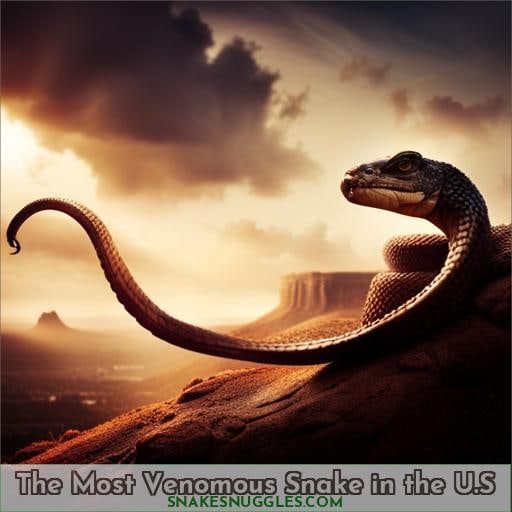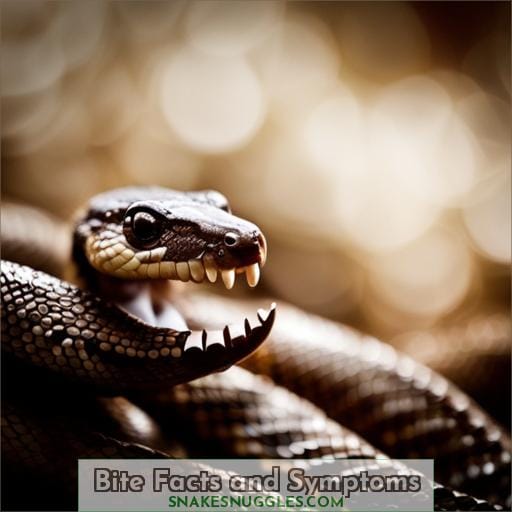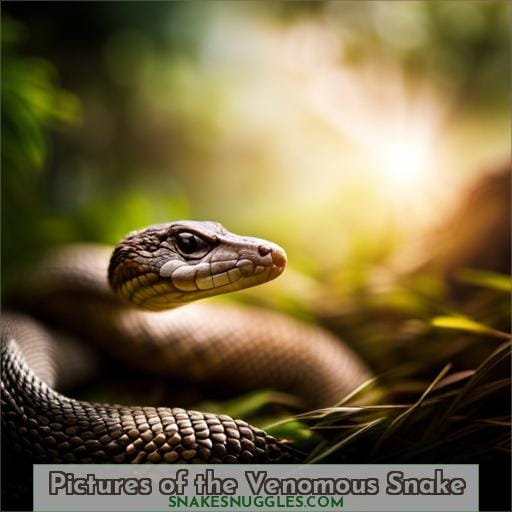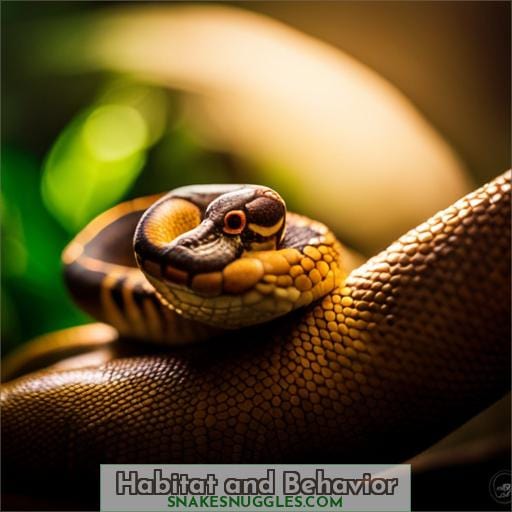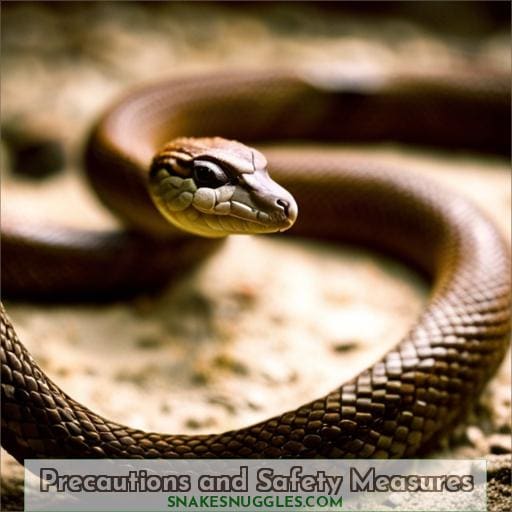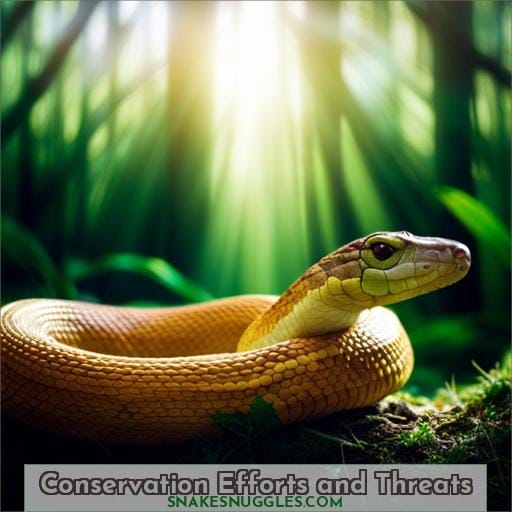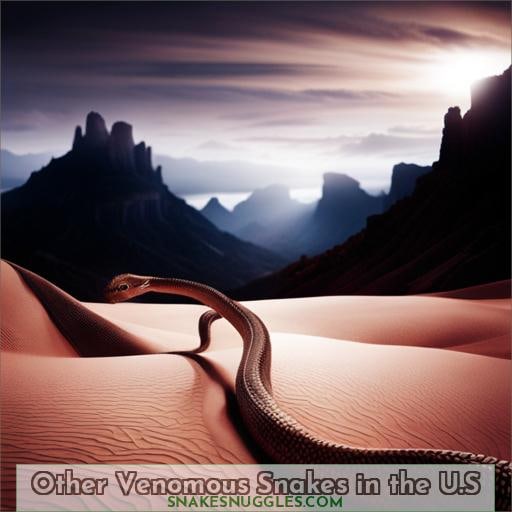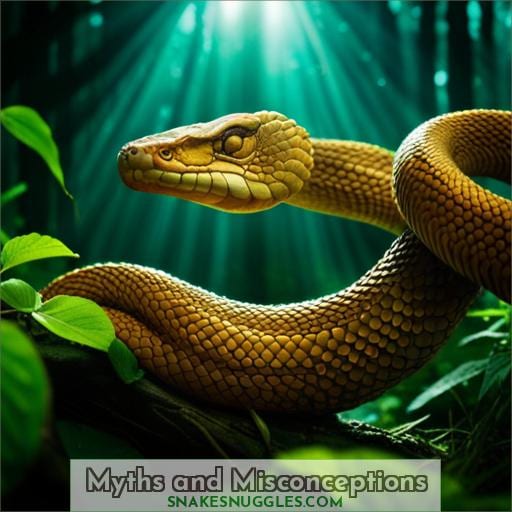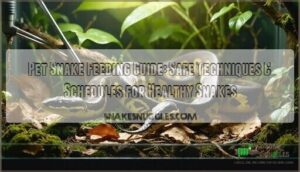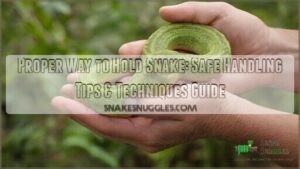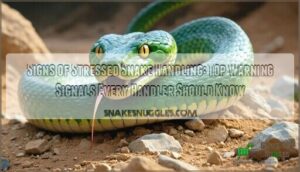This site is supported by our readers. We may earn a commission, at no cost to you, if you purchase through links.
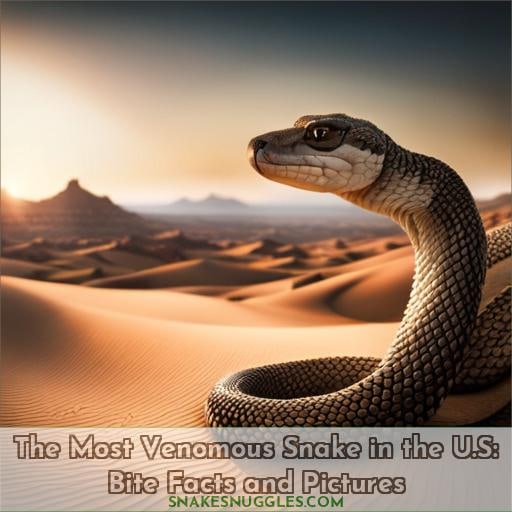 Imagine standing face to fangs with the most venomous snake in the U.S. Its potent venom can send shivers down your spine, but fear not! In this article, we’ll explore fascinating bite facts and provide captivating pictures of this deadly serpent.
Imagine standing face to fangs with the most venomous snake in the U.S. Its potent venom can send shivers down your spine, but fear not! In this article, we’ll explore fascinating bite facts and provide captivating pictures of this deadly serpent.
From its geographic distribution to physical characteristics, we’ll delve into everything you need to know about encountering this formidable creature.
Table Of Contents
- Key Takeaways
- The Most Venomous Snake in the U.S
- Bite Facts and Symptoms
- Pictures of the Venomous Snake
- Habitat and Behavior
- Precautions and Safety Measures
- Conservation Efforts and Threats
- Other Venomous Snakes in the U.S
- Myths and Misconceptions
- Frequently Asked Questions (FAQs)
- How many venomous snake species are found in the United States?
- What is the difference in venom potency between the most venomous snake in the U.S and other venomous snake species?
- Are there any specific regions in the U.S where the most venomous snake is commonly found?
- How do conservation efforts contribute to the protection of the most venomous snake in the U.S?
- What are the common myths and misconceptions associated with the most venomous snake in the U.S?
- Conclusion
Key Takeaways
- Triangular-shaped head and elliptical pupils are key features for venomous snake identification.
- Venomous snakes in the U.S. have a wide geographic distribution, with a preference for coastal dunes, pine forests, marshes, and swamps.
- Snake bites can cause severe symptoms such as puncture marks, swelling, nausea, and labored breathing, requiring urgent medical attention and appropriate antivenom.
- Conservation efforts are necessary to protect venomous snakes and their habitats from human-induced threats, with organizations working towards habitat restoration and public awareness.
The Most Venomous Snake in the U.S
When it comes to the title of the most venomous snake in the U.S, there are several factors to consider.
One important aspect is venom potency, which determines how lethal a snake’s bite can be.
Another factor is geographic distribution, as certain snakes may be more prevalent and pose a greater threat in specific regions.
Lastly, physical characteristics such as size and behavior play a role in determining which snake holds this notorious title.
Let’s delve into these points further to identify the most venomous snake in the U.
Venom Potency
If you encounter the most venomous snake in the U.S., its bite can deliver a potent venom capable of causing severe envenomation effects.
- Venom delivery:
The snake injects its venom through fangs, delivering a high quantity with each bite.
- Neurotoxin effects:
The potent neurotoxins target the respiratory centers in the brain, leading to respiratory arrest and cardiac failure.
- Antivenom challenges:
Limited production capabilities and regulatory control pose challenges for ensuring sufficient antivenom availability for effective treatment.
Geographic Distribution
The Most Venomous Snake in the U.S, the Eastern Diamondback Rattlesnake, can be found throughout the southeastern region of the country. Its geographic range extends from North Carolina to eastern Louisiana and as far south as Florida.
This species prefers habitats such as coastal dunes, pine forests, marshes, and swamps. Geographic analysis reveals that climate influences their distribution patterns and population dynamics.
The ecological impact of these venomous snakes on their prey populations is significant due to their predatory nature and role in maintaining ecosystem balance.
Physical Characteristics
When encountering the most venomous snake in the U.S, it’s important to familiarize yourself with its physical characteristics.
-
Physical Features:
- Can reach lengths of up to 18 feet
- Recognizable by its iconic hood and hissing sound
- Wide variation in coloration across different regions
-
Behavioral Patterns:
- Known for defensive stance against threats
- Capable of lifting a third of its body off the ground
- Adapted to diverse habitats: forests, swamps, grasslands
-
Species Identification:
- Scientific name: Ophiophagus hannah
Bite Facts and Symptoms
Now let’s delve into the bite facts and symptoms of the most venomous snake in the U.
The severity of bites can cause acute emergencies, with envenomation effects leading to respiratory arrest and cardiac failure. It’s crucial to understand first aid measures and seek immediate medical treatment for a chance at preventing irreversible damage.
Severity of Bites
When bitten by the most venomous snake in the U.S., you’ll experience severe symptoms that require immediate medical attention.
The severity of bites can vary depending on various factors, such as the amount of venom injected and individual susceptibility.
Clinical protocols for assessing bite severity are crucial in determining appropriate treatment strategies.
Accessible healthcare and community education play a vital role in minimizing mortality rates associated with envenoming.
Antivenoms are essential for mitigating the severity of bites and improving patient outcomes.
Envenomation Effects
After being bitten by the most venomous snake in the U.S., you may experience a range of envenomation effects.
These can include:
- Puncture marks at the wound
- Redness, swelling, and bruising around the bite area
- Severe pain and tenderness
Envenomation may also lead to:
- Nausea
- Vomiting
- Diarrhea
- Labored breathing
- Stopped breathing in extreme cases
It’s crucial to seek immediate medical attention for proper treatment and management of these envenomation effects.
First Aid and Treatment
If you’re bitten by the most venomous snake in the U.S, immediate first aid and medical treatment are crucial for minimizing potential harm.
- Seek immediate medical attention
- Take a photograph of the snake from a safe distance if possible
- Apply first aid while waiting for EMS assistance
- Antivenom is crucial for serious envenomation
Pictures of the Venomous Snake
Now let’s take a closer look at the visual aspects of this venomous snake. Identification features play a crucial role in distinguishing it from other species, and pictures can provide valuable insights into its unique characteristics.
By examining detailed photographs, you’ll gain a better understanding of the physical attributes that make this snake one of the most venomous in the United States.
Identification Features
To properly identify the most venomous snake in the U.S. it’s essential to recognize key characteristics such as triangular heads and heat-sensing pit organs.S, you can rely on its distinct physical characteristics.
This snake is known for its:
- Triangular-shaped head
- Elliptical pupils
- Heat-sensing pits located between its eyes and nostrils that help it detect prey in low light conditions.
Its body is covered in scales, with a pattern of dark brown or black patches on a lighter background color.
| Physical Characteristics | Behavioral Patterns |
|---|---|
| Triangular-shaped head | Defensive posture |
| Elliptical pupils | Hunting strategies |
| Heat-sensing pits | Reproductive cycles |
Visual Representation of the Snake
Take a look at the visual representation of this venomous snake, providing a clear image for identification purposes. The pictures showcase its distinct features and coloration variations influenced by geography.
Recognizable by its iconic hood and defensive posture, this protected species exhibits remarkable predatory behavior. Its anatomy allows for efficient venom delivery during envenomation, making it one of the most potent snakes in the U.
Additionally, these visuals highlight their unique egg nesting habits and maternal guarding behaviors that contribute to their survival in diverse habitats.
Habitat and Behavior
The habitat of the most venomous snake in the U.S., known as the Eastern Diamondback Rattlesnake, spans across southeastern states such as Florida and Georgia. These snakes are adaptable to various environments including pine flatwoods, sandhills, hammocks, and even coastal dunes.
They’re primarily active during warmer months and prefer areas with ample cover such as palmetto thickets or fallen logs.
When it comes to behavior, Eastern Diamondbacks are generally solitary creatures that rely on their excellent camouflage for hunting ambush-style.
Natural Environment
In the natural environment, the most venomous snake in the U.S can be found inhabiting a variety of habitats including forests, swamps, and grasslands. These natural habitats provide diverse ecosystems that support various wildlife species.
However, human activities such as deforestation and habitat destruction have had a significant environmental impact on these areas. To ensure biodiversity preservation and wildlife conservation efforts are needed to protect these valuable ecosystems from further degradation.
Additionally, community engagement plays a crucial role in raising awareness about the importance of preserving natural habitats for future generations.
The most venomous snake in the U.S., known as The Eastern Diamondback Rattlesnake (Crotalus adamanteus), is primarily found within southeastern states such as Florida and Georgia but can also be spotted along coastal regions stretching up to North Carolina.
These snakes prefer sandy or loamy soils with dense vegetation cover provided by forests or swamps.
Eastern diamondbacks play an essential role within their ecosystem dynamics by controlling populations of small mammals like rats through predation. Their presence helps maintain balanced ecological relationships between different animal species.
However, their population has been declining due to habitat loss caused by urban development, industrialization and agricultural expansion.
Conservation efforts aim at protecting their native environments while implementing measures for sustainable land-use practices to mitigate negative impacts on local populations.
Furthermore, educational initiatives promote public understanding about snakes’ vital roles within ecosystems while dispelling myths perpetuated by snake charmers commonly associated with Southeast Asia.
In conclusion, preserving natural habitats is crucial not only for maintaining biodiversity but also ensuring long-term sustainability of our planet’s delicate balance.
Hunting and Feeding Habits
As for its hunting and feeding habits, the most venomous snake in the U.S utilizes a variety of strategies to capture and consume its prey.
With their predatory instincts finely tuned, they employ stealthy movements and lightning-fast strikes to catch unsuspecting victims.
Their preferred prey includes small mammals, birds, amphibians, and reptiles.
Once caught, they inject potent venom into their prey’s body through hollow fangs before swallowing them whole.
The digestive process then begins as enzymes break down the prey’s tissues for absorption.
Reproduction and Life Cycle
Continuing our exploration of the habitat and behavior of the most venomous snake in the U.
- Snake Reproduction: The snakes reproduce sexually through mating behaviors.
- Life Stages: They go through various stages including birth, growth, maturity, and eventually death.
- Mating Behaviors: These include courtship rituals such as dancing or combat to attract a mate.
- Offspring Development: The female lays eggs which hatch after an incubation period.
- Reproductive Cycles: Snakes have specific times during which they mate and lay eggs.
Precautions and Safety Measures
To minimize your risk of encountering the most venomous snake in the U.S, it’s crucial to be aware of precautions and safety measures.
Firstly, avoid encounters by staying on designated trails and keeping a safe distance from potential snake habitats.
Secondly, wear protective clothing and gear such as long pants, closed-toe shoes or boots, gloves, and ankle gaiters to reduce exposure.
Lastly, if you do spot a snake while hiking or exploring outdoor areas, respond calmly by slowly backing away without making sudden movements that may provoke an attack.
Avoiding Encounters
To avoid potentially dangerous encounters with the most venomous snake in the U.S.
Be aware of behavioral cues, such as hissing or hooding, which indicate agitation or potential attack.
Maintain safe distances from snakes and their habitats, keeping in mind that they can strike up to half their body length away.
Educate yourself through programs on snake identification and behavior.
Take preventive steps by wearing appropriate protective clothing when venturing into known snake territories.
| Safety Measures | Description |
|---|---|
| Behavioral Cues | Learn how to recognize signs of aggression or threat displayed by venomous snakes, such as hissing sound or raised hood posture. |
| Safe Distances | Keep a distance of at least twice the length of the snake between you and any encountered venomous species for your own safety. |
| Habitat Awareness | Understand where these snakes are commonly found within their natural habitat so that you can exercise caution accordingly during outdoor activities. |
| Education Programs | Attend educational programs offered by local wildlife organizations to gain knowledge about different species’ habits, |
behavior patterns,and proper response techniques.
Preventive Steps
to harboring venomous creatures.Always be cautious when reaching into hidden spaces,such as rock crevicesor fallen logs,to reduce
the riskof encountering a hidden serpent.
Protective Clothing and Gear
When encountering venomous snakes, it’s crucial to protect yourself by wearing appropriate clothing and gear.
Protective measures such as thick pants, boots, and long-sleeved shirts can minimize the risk of snake bites.
Safety gear like snake gaiters or chaps provide an extra layer of protection for your lower legs.
The effectiveness of these gears depends on their design and material quality.
When selecting attire choices and equipment, prioritize those specifically designed for snakebite prevention to ensure maximum safety during encounters with venomous snakes.
Proper Response to Snake Sightings
If you encounter a venomous snake, it’s important to respond appropriately and ensure your safety.
Understanding snake behavior can help alleviate fears and increase preparedness.
Educational programs play a vital role in teaching communities about the environmental impact of snakes and how to safely coexist with them.
Community engagement is crucial for promoting awareness, implementing safety measures, and conserving snake populations.
By taking these precautions, we can minimize the risks associated with snake sightings while fostering harmony between humans and snakes in our environment.
Conservation Efforts and Threats
When it comes to conservation efforts for the most venomous snake in the U.S, human impact on snake populations is a significant concern.
Habitat destruction and fragmentation pose serious threats to their survival.
However, there are several organizations and initiatives dedicated to protecting these snakes and their habitats, working towards raising awareness about their importance in ecosystems and implementing measures for their preservation.
Human Impact on Snake Populations
As we delve into the topic of human impact on snake populations, let’s explore how our actions and choices have influenced their conservation efforts and posed threats to their survival.
Human interaction with snakes has had a significant ecological impact, leading to biodiversity loss due to habitat destruction and fragmentation.
However, there are also ongoing conservation strategies aimed at preserving these fascinating creatures and promoting wildlife preservation.
Habitat Destruction and Fragmentation
To protect the most venomous snake in the U.S, it’s crucial to address the ongoing threats of habitat destruction and fragmentation.
- Habitat Restoration: Restoring degraded habitats to provide suitable environments for snakes.
- Ecosystem Connectivity: Creating corridors that connect fragmented habitats, allowing snakes to move freely and maintain genetic diversity.
- Biodiversity Preservation: Protecting not only the king cobra but also other species that depend on these habitats through effective land management practices and wildlife corridors.
Conservation Initiatives and Organizations
To address the threats of habitat destruction and fragmentation to venomous snakes in the U.S., various conservation initiatives and organizations have been working tirelessly to protect these species.
- Species preservation
- Habitat restoration
- Community engagement
- Biodiversity protection
By implementing effective strategies such as:
- Creating protected areas
- Conducting research on snake populations and habitats
- Raising public awareness about their importance in ecosystems,
these organizations are making significant strides towards safeguarding venomous snakes from further decline.
Other Venomous Snakes in the U.S
Let’s explore the diversity of venomous snakes found in the United States, including their common species and unique characteristics.
From rattlesnakes to copperheads, these snakes possess a range of venom types and delivery methods that make them formidable predators. The venom composition of these snakes, similar to those found in Australia, including Inland Taipan’s potent mix, typically contains a complex mixture of toxins, proteins, and enzymes. Understanding their behaviors and habitats can help us better navigate encounters with these venomous creatures in our surroundings.
Diversity of Venomous Snakes
Now let’s explore the diversity of venomous snakes found in the U.S. These fascinating creatures have evolved unique adaptations and occupy various ecological niches across different regions.
From venom variations to behavioral patterns, each species has its own distinct characteristics. Taxonomic classifications further categorize these snakes into specific groups based on their evolutionary relationships.
Understanding the diverse nature of venomous snakes is crucial for gaining mastery over their complexities and ensuring our safety in their presence.
Common Species and Their Characteristics
Identify the common venomous snake species found in the U.S. and learn about their unique characteristics.
The United States is home to several venomous snakes, including the:
- Eastern Diamondback Rattlesnake
- Timber Rattlesnake
- Copperhead Snake
- Cottonmouth Snake (also known as Water Moccasin)
- Coral Snake
Each of these snakes possesses distinct physical traits and behaviors that contribute to their survival in various habitats across the country. Understanding these characteristics is essential for both appreciating their ecological role and ensuring safe human interactions with these venomous reptiles.
Myths and Misconceptions
There are many myths and misconceptions surrounding venomous snakes, particularly the most venomous snake in the U.S. It’s important to separate fact from fiction when it comes to understanding these dangerous creatures.
By debunking common misunderstandings and providing accurate information, we can educate ourselves about their behavior, habitats, and potential threats they pose.
Separating Fact From Fiction
One common myth about venomous snakes in the U.S is that their bites are always fatal.
Separating fact from fiction when it comes to venomous snake bites is essential for public understanding and safety. Folklore analysis, media representation, educational campaigns, public perception, and behavioral studies contribute to debunking misconceptions surrounding these creatures.
It’s important to rely on scientific knowledge rather than myths or sensationalized portrayals in order to make informed decisions regarding snake encounters.
Common Myths About Venomous Snakes
Busting common myths about venomous snakes can help you stay informed and safe.
Contrary to cultural beliefs, not all venomous snakes are aggressive and ready to attack humans.
Education plays a crucial role in dispelling misconceptions surrounding these reptiles and encouraging safety precautions when encountering them.
By promoting educational outreach and conservation efforts, we can foster a better understanding of these fascinating creatures while ensuring their protection in the wild.
Frequently Asked Questions (FAQs)
How many venomous snake species are found in the United States?
There are approximately 20 species of venomous snakes found in the United States.
These include the rattlesnake, copperhead, cottonmouth (also known as water moccasin), and coral snake.
Each species possesses its own unique characteristics and potential dangers.
What is the difference in venom potency between the most venomous snake in the U.S and other venomous snake species?
The difference in venom potency between the most venomous snake in the U.S and other species lies in their neurotoxin delivery.
The highly potent venom of the former poses a greater risk, causing respiratory arrest and cardiac failure, making effective antivenoms crucial for survival.
Are there any specific regions in the U.S where the most venomous snake is commonly found?
The most venomous snake in the U.S, the Eastern Diamondback Rattlesnake, is commonly found in specific regions such as:
- Pine forests
- Sandy coastal areas
of southeastern states like Florida and Georgia.
How do conservation efforts contribute to the protection of the most venomous snake in the U.S?
Conservation efforts play a vital role in safeguarding the most venomous snake in the U.
They focus on:
- Habitat protection
- Raising awareness
- Combating illegal wildlife trade
Collaborations with organizations aim to ensure its survival for future generations.
What are the common myths and misconceptions associated with the most venomous snake in the U.S?
Common myths and misconceptions surrounding the most venomous snake in the U.S include beliefs that:
- It attacks unprovoked
- Is aggressive towards humans
- Has an insatiable desire to attack
However, these notions are unfounded as this snake typically only bites when threatened or cornered.
Conclusion
To sum up, the most venomous snake in the U.S is a formidable creature with potent venom that can instill fear.
Its geographic distribution spans across certain regions, and it possesses distinct physical characteristics.
Understanding bite facts and symptoms is crucial, as severity can vary.
Precautions and safety measures should be taken to avoid encounters, and conservation efforts are necessary to protect snake populations.

